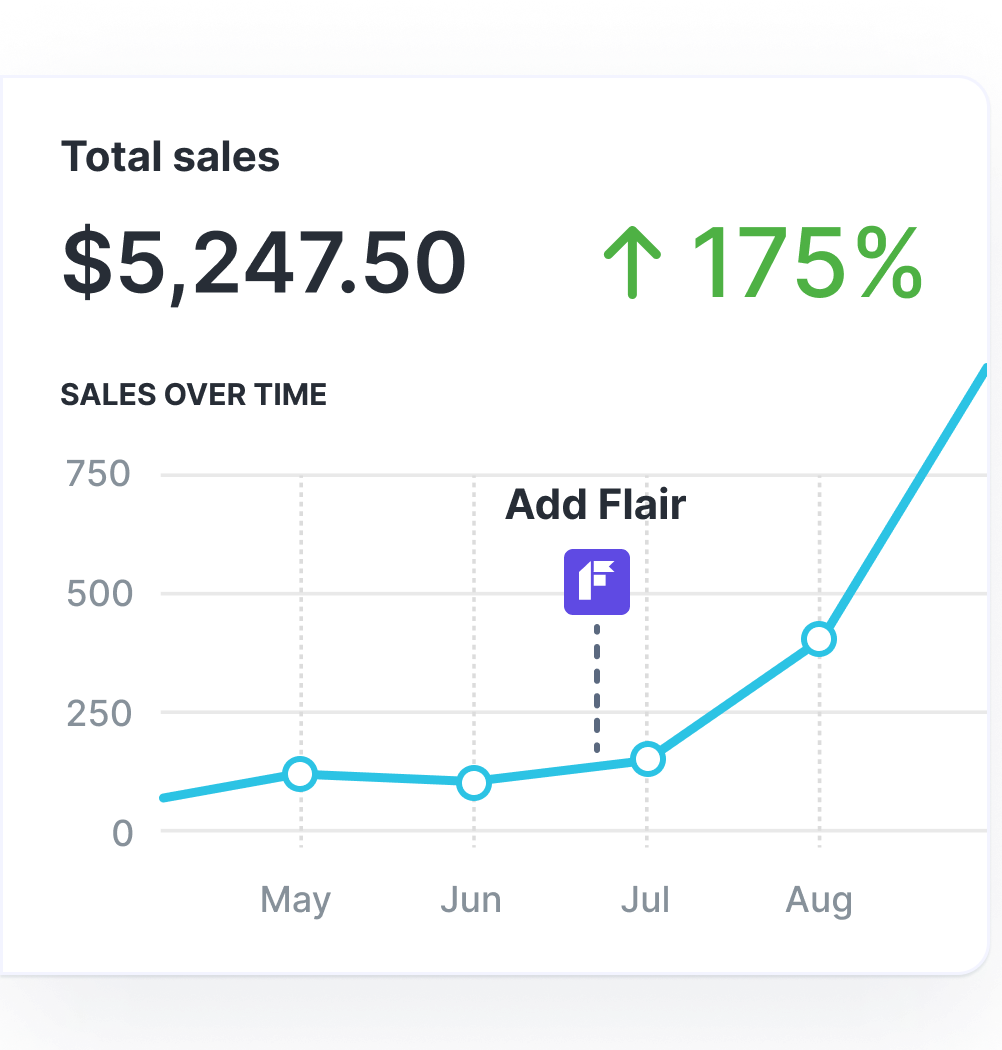Essential Shopify Statistics You Need To Know in 2025

Want to know how many people use Shopify, how much money Shopify is worth, or how many sales Shopify merchants are generating?
You’re in the right place because we’ve curated the most in-depth and up-to-date selection of Shopify statistics for 2025, covering the following categories:
- The history of Shopify
- How many merchants use Shopify
- How much money Shopify merchants make
- How much money Shopify earns
- General e-commerce trends
Let’s get into it…
Shopify’s Story: Where They Came From & Where They Are Today
Headline facts & stats:
- Shopify started life as an online snowboard store called Snowdevil.
- Co-founder Tobi Lütke built Snowdevil using Ruby on Rails before he and business partner Scott Lake realized the software underpinning the site was worth more than the store itself.
Shopify co-founders Tobi Lütke and Scott Lake never intended to create one of the world’s biggest e-commerce platforms. They started out building an e-commerce store called Snowdevil (which still exists today as a Shopify demo store [1])...

… but quickly realized the real opportunity lay in the custom software running their e-commerce store.
With help from Tobi’s old school friend Daniel Weinand, they spent 18 months turning it into a user-friendly platform that would allow anyone to build an e-commerce store [2].
The rest, as they say, is history.
Shopify Timeline
Here are some of the key milestones in the history of Shopify:
- 2006: Shopify is born [3].
- 2007: Shopify rolls out its secure shopping cart system. Over the next three years, it generates $100+ million in net sales for merchants [4].
- 2009: The first iteration of the Shopify App Store launches with fewer than a dozen apps. Four years later, the App Store has expanded to 100 apps and is run by a three-person team [5]. Today, over 13,000 applications are available through the Shopify app store [6].
- 2013: Shopify Payments launches, giving merchants in the US and Canada access to a powerful and easy-to-use credit card processing system [7]. By 2019, Shopify Payments is available in over a dozen countries and is processing $16+ billion per year globally [8].
- 2017: Shopify announces a partnership with Amazon, allowing Shopify merchants to add the Amazon sales channel to their Shopify accounts — connecting them to millions of Amazon shoppers [9].
- 2020: Shopify transitions into a remote-first workforce in response to the coronavirus pandemic [10]. It’s still remote-first today and now has 8,300+ employees [6:1].
- 2023: Shopify launches its all-new Partner Directory, giving merchants access to a curated list of platform experts [11]. Today, users can get support from a network of 780+ approved third-party agencies and freelancers, known as "Shopify experts” [6:2].
Pro Tip: For more e-commerce trends, check out our related guide: Top Ecommerce Trends - What Online Retails Need to Know Now.
How Many Merchants Use Shopify? Where Are They Located?
Headline facts & stats:
28% of US online stores use Shopify [12], making it the country’s largest e-commerce platform.
There are currently 2+ million merchants [13] and 4.6 million live websites [14] using Shopify.

Shopify usage statistics suggest that Tobi Lütke and Scott Lake were right to pivot from snowboard sales to e-commerce software.
10.32% of Global e-commerce stores use Shopify [15], making it the fourth most popular e-commerce platform worldwide.

“Nonetheless, Shopify holds the leading position across several major markets.”
- The three countries with the most Shopify stores are the US (2.8 million), the UK (203,835), and Australia (149,342) [14:1]. In each of those countries (and lots more besides), Shopify is comfortably the biggest e-commerce platform [16][17][18].
- And it’s not just a hit in the Anglophone world: Shopify is also top dog in markets like Brazil [19] and Germany [20]. In part, that’s down to the fact that Shopify allows merchants to create online stores in 20 different languages [21].
“Shopify Captures 25% of Top Global E-commerce Brands”

The vast majority of Shopify merchants are tiny operations: one-person businesses selling drop-shipped T-shirts, homemade candles, and the like.
But it’s also supremely popular among the world’s largest e-commerce brands.
- Of the top one million websites globally, about one in four use Shopify, while roughly one in seven favor WooCommerce Checkout and one in 12 are powered by Magento [22].
And that’s without even mentioning the 6% of big online retailers that use Shopify Plus [22:1], the platform’s enterprise-grade offering.
- Priced at $2,500+ per month [23], Shopify Plus is simply too expensive for most e-commerce businesses. Yet it’s used by 49,000+ online stores [24], including household names like Allbirds, Heinz, and Staples [25].
- Over half (27,930) of Shopify Plus users are in the US, while the next-biggest markets are the UK (3,411), Australia (3,113), Canada (2,916), and Germany (1,360) [24:1].

“Shopify's Support Team Handles 80,000 Live Tickets Weekly”
- Given its extensive customer base, Shopify ensures robust support, effectively handling 80,000 live tickets and over 95,000 interactions via its AI-powered help center each week [26].
“Over 90% of Shopify Merchants Choose Shopify Payments”
Whether big or small, the overwhelming majority of Shopify merchants use Shopify Payments, the platform’s built-in payment service that handles every step in the online transaction process. In total, 1.8 million merchants use Shopify Payments, representing up to 90% of all Shopify users [27].
It’d likely be an even higher proportion if Shopify Payments were available beyond the 23 countries [28] it currently serves.
How Much Can Shopify Merchants Earn?
Headline facts & stats:
- Since its launch in 2006, Shopify has processed $886+ billion in e-commerce sales [29].
- 561 million unique shoppers purchased from Shopify merchants in 2022 alone [30].
- Shopify has an estimated average order value of $85 [31].
Since Shopify began greasing the wheels of global business back in 2006, the platform has processed hundreds of billions of dollars worth of e-commerce sales [29:1]. Today, it handles 10,978 requests every single minute [32].
“In the USA, the typical Shopify store generates $67,000 per year, with an average order value of $85”
All of this means that (a lot of) Shopify merchants are making bank, with Shopify stores seeing an average order value of $85 [31:1] and earning an average revenue of $92 per customer [33].
How does Shopify enable online retailers to deliver such impressive results?
In part, it’s because the platform makes it easy for users to build high-performing e-commerce sites — even if they don’t know how to code.
“On Average, Shopify Stores Achieve 1.4% Average Conversion Rate”
- Across all devices, Shopify stores see an average conversion rate of 1.4%, while the top 10% of stores report conversion rates of 4.7%+ [34]. That’s doubly impressive given that 79% of Shopify traffic comes from mobile [35], which tends to see significantly lower conversion rates than desktop [36].
- Of course, not all channels convert equally. Email is the best-converting referrer for Shopify stores, delivering an average conversion rate of 4.29%, followed by search, direct, and social [37].

Pro tip: Not sure what your Shopify conversion rate is? Check out our guide: How to Find Your Shopify Conversion Rate (Step-by-Step Guide)
How Much Can Shopify Merchants Earn During the Cyber Weekend?
“Shopify Merchants Hit Record $9.3 Billion Sales During 2023 BFCM Weekend, Up 24% Yearly”
- Shopify merchants generated record sales of $9.3 billion across the 2023 BFCM weekend, up 24% year on year, with 61+ million customers purchasing from Shopify stores between early Friday (November 24) in New Zealand and late Monday (November 27) in California [38].
- Peak per-minute sales of $4.2 million were recorded at 12:01 PM EST on November 24, while the busiest period for traffic saw Shopify handling a giddying 967,000 requests per second — equivalent to 58 million per minute [38:1].
- It was a big moment for new e-commerce stores, 17,500+ of which generated their first Shopify sales during the Cyber Weekend. But it wasn’t all about the newbies: 55,000 existing merchants also reported their best-ever sales days [38:2].
- The Cyber Weekend is very much a global affair, with cross-border transactions making up over one-seventh (15%) of all orders. The highest sales by country were recorded in the US, UK, Australia, Canada, and Germany, while Los Angeles, New York, and London topped the city rankings [38:3].

Regardless of location or store type, Shopify merchants enjoyed average Cyber Weekend cart values of $108.12 [38:4]. Still, some niches inevitably performed better than others, with the top-selling product categories comprising:
- Clothing and accessories
- Beauty and health
- Home and garden
Despite all those transactions, Shopify remained committed to sustainability, removing 56,000+ tonnes of carbon across the weekend to offset shipping emissions [38:5].
How Much Money Does Shopify Make & Where Does It Come From?
Headline facts & stats:

“Shopify's 2023 Revenue Hit $7.1 Billion”
- Shopify is currently valued at $114+ billion [39]— almost 100X more than its valuation when the company went public on the New York Stock Exchange back in 2015 [40].
- Shopify earned $7.1 billion in total revenue in 2023, up 26% year on year [41].
Unsurprisingly, Shopify merchants aren’t the only people making money here: Shopify is certainly taking its slice of the pie.
- According to a Shopify investor deck, Shopify has a 5.9% share of all retail e-commerce sales in the US, putting it second only to Amazon with 37.3% [42]. As if that wasn’t enough, its enterprise product, Shopify Plus, has a 10% share of the total US e-commerce market [43].
In short, it’s a pretty big deal.
- The company posted a gross profit of $3.5 billion in 2023, compared with $2.8 billion in 2022. Gross merchandise volume (GMV) reached $235.9 billion, while monthly recurring revenue increased 35% to $149 million in Q4 [41:1].
You might assume the lion’s share of Shopify’s profits come from subscriptions, just like any SaaS platform. But you’d be wrong.
“In Q4 of 2023 alone, Shopify earned $525 million from subscription fees.”
- Sure, subscriptions are a key earner, generating revenues of $525 million in Q4 2023 alone — including $46 million per month from Shopify Plus subscribers [41:2].
- But the platform has a bunch of other revenue streams. Revenue from merchant solutions rose 21% year on year in Q4 2023 to $1.6 billion — largely driven by GMV growth and increased use of Shopify Payments — while gross payments volume increased to $45.1 billion in the same period [41:3].
- And then there’s Shop Pay, Shopify’s accelerated checkout option, which has generated a cumulative GMV of $110 billion since its launch in 2017 [44].

“25 million new leads signed up for a free Shopify Trial in 2023”
- Most importantly, Shopify’s growth shows no signs of slowing. Quite the opposite, in fact, given that 25 million new leads signed up for a Shopify free trial in 2023 [45].
- This explains why Shopify’s stock price is edging toward the $100 mark at the time of writing — the highest it’s been in two years (albeit still a long way behind the company’s all-time-high stock price of $169.06, achieved in November 2021) [46].
Beyond Shopify: General E-Commerce Statistics
Pro Tip: For more e-commerce trends, check out our related guide: 26+ E-Commerce Statistics & Consumer Trends.
Headline facts & stats:

- By 2026, e-commerce retail sales are expected to hit $9.4 trillion globally [47].
- Combined online and offline retail sales reached $25.8 trillion in 2022 [47:1].
- There will be an estimated 4.5 billion online shoppers by 2028 [48].
If people stopped buying stuff online, Shopify would be out of business faster than you can say “omnichannel retail”.
“Global E-Commerce Sales Projected to Grow to $9.4 Trillion by 2026”
- However, it doesn’t look like that’s going to happen any time soon (or ever). Global e-commerce sales are expected to rise from $5.8 trillion in 2022 to $9.4 trillion in 2026 [47:2], while average revenue per user is forecast to reach $1,079 in 2024 [48:1].
Where’s all that growth coming from? Surely there’s a limit to how much stuff we can buy?
You probably won’t be surprised to hear that, for the most part, it’s not being driven by Western consumers.
“China Leads Global E-Commerce with $935.13 Billion Revenue in 2023, 884 Million Online Shoppers”
- The Philippines and India top the list of countries with the fastest e-commerce growth rates, at 24.1% and 22.3% respectively [49].
- Then there’s China, the biggest player in the global e-commerce market, with combined annual revenues of $935.13 billion in 2023 [50]. As of June 2023, approximately 884 million people in China have made online purchases [50:1], and that number is only going to increase going forward.
- Globally, the average online shopper spends approximately $2.74 per visit to an e-commerce store [51]. But that statistic doesn’t tell the full story, because the numbers vary massively from one niche to another. The top categories for average spend per visit are household furniture ($3.42 per visit) and health and beauty ($2.85 per visit) [51:1].
Whether or not you’re in one of those high-earning niches, it’s essential you leverage the right promotional channels to generate store traffic (and, hopefully, sales).
- In the US, three-fifths of online shoppers start searching for products on Amazon, while half use a search engine and one-third head to Walmart.com [52].

And don’t forget social media, which is an increasingly popular source of product inspiration.
- About one-fifth of consumers start their online shopping journeys on YouTube and Facebook [52:1], while almost half of shoppers in the US have already made purchases through social media — and a further three-fifths say they’re interested in doing so [53].
Final Thoughts
Online sales are only going in one direction: up and to the right.
As far as we’re concerned, if you want a slice of the pie, your best bet is to start a Shopify store.
It’s comparatively affordable. It’s super user-friendly. And it’s highly customizable, thanks to the wealth of apps available in the Shopify App Store (8,000+ and counting).
Ready to begin your Shopify journey? Check out our article: How Does Shopify Work & What Is It? Get Started Guide.
Or if you’ve already built your first store, learn how to drive more sales and revenue in our guide: How To Increase Conversion Rates on Shopify.

Grow Your Shopify Sales by over 175% with Flair
-
Increase sales using product badges and sales banners
-
Maximize conversions with scarcity, urgency and countdown timers
-
Automate promotions with targeted rules and scheduling
References
On Scaling, Search, and Design Sprints: The Story of the New Shopify App Store ↩︎
Top global e-commerce platforms market share 2023 | Statista ↩︎
US eCommerce Usage Distribution in the Top 1 Million Sites ↩︎
UK eCommerce Usage Distribution in the Top 1 Million Sites ↩︎
AU eCommerce Usage Distribution in the Top 1 Million Sites ↩︎
BR eCommerce Usage Distribution in the Top 1 Million Sites ↩︎
DE eCommerce Usage Distribution in the Top 1 Million Sites ↩︎
Distribution for websites using eCommerce technologies ↩︎ ↩︎
Shopify 2022 Year in Review: Make Commerce Better for Everyone ↩︎
Average average order value for Shopify | Littledata Benchmarks ↩︎ ↩︎
Shopify Plus Platform | The commerce software for fast-growing brands ↩︎
Average revenue per customer for Shopify | Littledata Benchmarks ↩︎
Average ecommerce conversion rate (all devices) for Shopify | Littledata Benchmarks ↩︎
The Future of Mobile Shopping and How to Optimize Your Site ↩︎
9 Customer Retention Strategies and Examples To Drive Customer Loyalty ↩︎
Shopify merchants drive record-high $9.3 billion in Black Friday-Cyber Monday sales ↩︎ ↩︎ ↩︎ ↩︎ ↩︎ ↩︎
Canadian software maker Shopify valued at $1.27 billion at IPO price | Reuters ↩︎
Shopify Announces Fourth-Quarter and Full-Year 2023 Financial Results ↩︎ ↩︎ ↩︎ ↩︎
Shopify Plus Platform | The commerce software for fast-growing brands ↩︎
Shopify - 9 Year Stock Price History | SHOP | MacroTrends ↩︎
Retail sales by channel worldwide 2022-2026 | Statista ↩︎ ↩︎ ↩︎
Leading countries based on retail e-commerce sales growth in 2023 ↩︎
Global online shopper per visit spend 2023, by category ↩︎ ↩︎
Shoppers start their product search on Amazon - Insider Intelligence Trends, Forecasts & Statistics ↩︎ ↩︎
Nearly half of US consumers say they have made a purchase through social media | Mintel ↩︎




